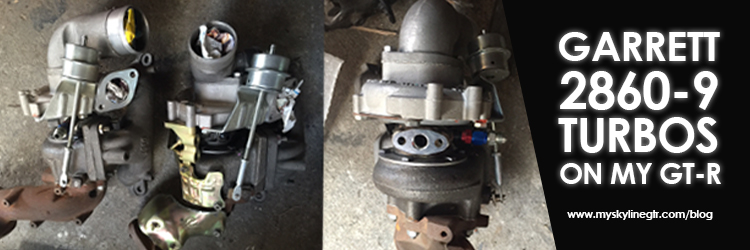After being defected I had to rethink the turbo setup I had to go with. I needed a setup that’ll give me good drivability and power with the most important factor; being able to clear my defect. I had only one option and the single turbo setup had to make way for a pair of Garrett 2860-9 turbos.
Popularity of low mount twin turbos
In the late 2000’s the import car scene was dying out due to police operations. It was clear the authorities wanted these cars off the road and they were very successful in doing it. However, for those that held onto their GT-R’s they needed a way to modify their cars without attracting too much attention if the police pulled the car over and did a roadside inspection. This is when the popularity of the twin turbo setup grew.
The popularity of the low mount turbos was focused around 3 Garrett turbo combinations. The 2860-9, 2860-5 and the 2860-10. You can argue that people were also using 2860-7’s which were the GT-R N1 equivalents but those turbos were for people that didn’t have a lot of supporting modifications.
Garrett 2860-9
These were the HKS GT-SS equivalents and one of the more popular setups people used on standard capacity RB26’s. These are a super responsive turbo and perfect for the street driven GT-R. On pump fuel I have seen these turbos make around 330 rear wheel kilowatts but on e85 I have seen these make around the 400rwkw. Nice turbo combo for the street.
My brother had a R33 GT-R with the GT-SS setup on a standard motor. The car drove very well and accelerated amazingly. The response through corners made it a fast street car. It did feel like is topped out towards the top end and I personally feel on a standard capacity motor it might struggle on a track with long straights.
It is for this reason I got the 2 bar rated actuators for my Garrett 2860-9 turbo setup. I’m also hoping my 2.7Ltr bottom end will make this a livelier setup to my brothers GT-R.
Garrett 2860-5
This is the HKS 2530 equivalent and is a bit laggy on a 2.6L but boy does this setup pack a punch. I’ve seen people hit 450rwkw with this setup on their GT-R, with e85 who knows how much more.
I drove my friends 33 GT-R with this combo and downlow there wasn’t anything much. Bit sluggish. But when the turbos are on boost the car moved. I drove his car a few times and I soon learnt that you need to keep the car on power band; keep the revs up. When I drove like this the car was pretty good around corners.
For an everyday street driven GT-R I think this turbo is a bit big for a standard capacity RB26. On something like a 2.8 this turbo will be a mean setup for track and street.
Garrett 2860-10
This is the HKS GT-RS equivalents and has the largest horsepower rating of all the turbos discussed here. This setup on a standard capacity RB26 is a lag monster. I have spoken to a few people with this turbo setup on their GT-R and the general consensus is that the Garrett 2860-10 setup works best with a 3Ltr bottom end. Even a 2.8Ltr stroker seems a little too small to get the turbos working efficiently enough for a street/ race setup.
I have never driven a GT-R with a GT-RS or Garrett 2860-10 setup so I can’t comment on what it’s like. But when I was considering running this setup I was looking into a 3ltr bottom end conversion. Just to give you an idea on the setups drivability on a standard RB26.
My goals with the Garrett 2860-9 turbos
Obviously I bought these turbos to put the car back close to stock as possible. I’m using standard piping and everything will be like a factory engine bay. My main goal is to pass the EPA and roadworthy in Victoria.
Along the way though I hope that I can squeeze 400kw out of these turbos on e85. Considering I am running a 2.7ltr I think this combo will be lively on the street and great on the race track. It is true that I do have plans to go to a single in the near future but I hope to enjoy this setup for the time being.

